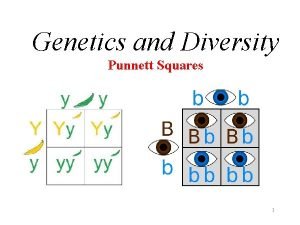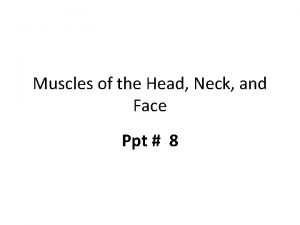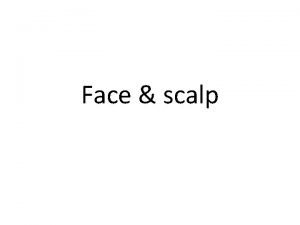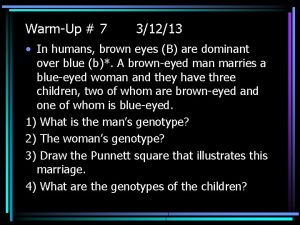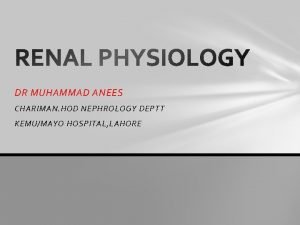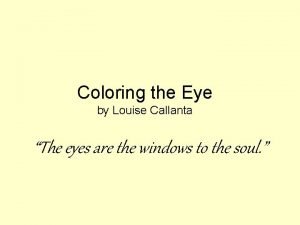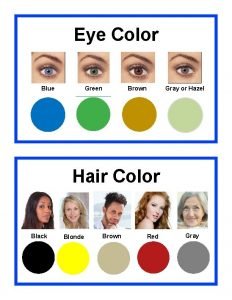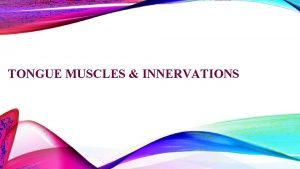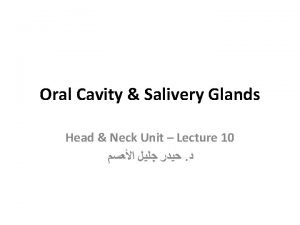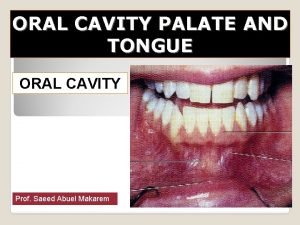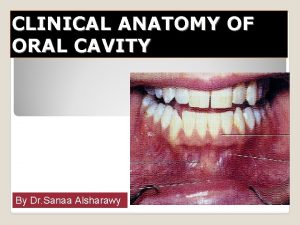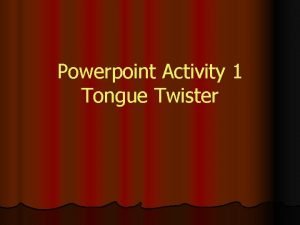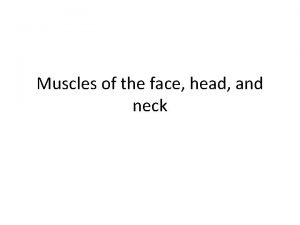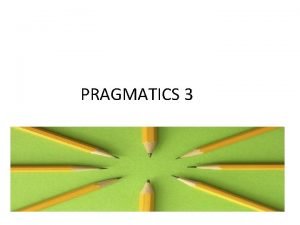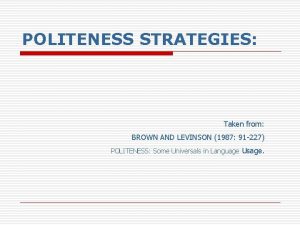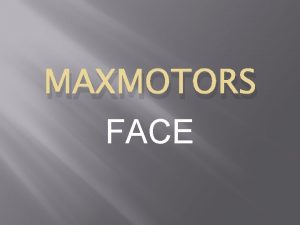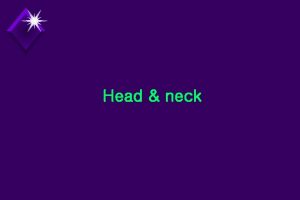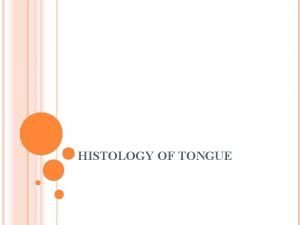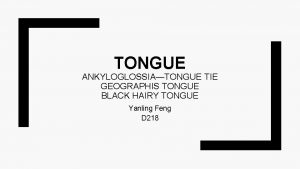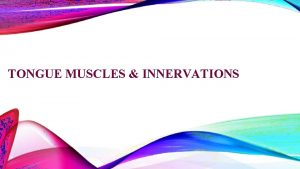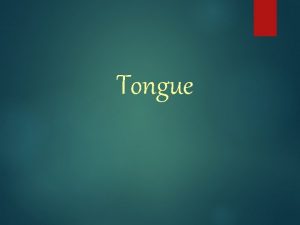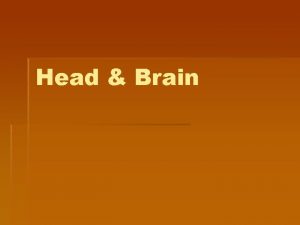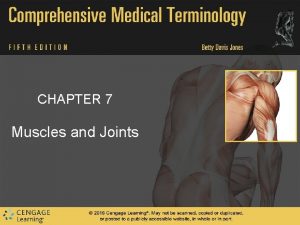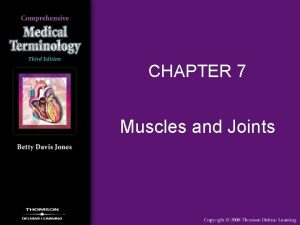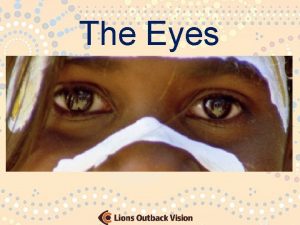Muscles of the Head Face Eyes Tongue and














- Slides: 14

Muscles of the Head

Face, Eyes, Tongue and Throat • Plan: – Facial expression – Tongue – Throat – Chewing/Swallowing – Speech

Muscles grouped for function • • Facial Expression Eye movements Move the lower jaw The tongue – Extrinsic – move the tongue – Intrinsic – inside the tongue • Soft palate • Pharynx • Larynx

Facial expression • Facial expression is vital for communication, especially of emotions • 6/7 basic expressions – – – – Happiness Sadness Fear Anger Surprise Disgust (Contempt) • More than 20 actual expressions – the basics are combined e. g. Happily surprised, happily disgusted, etc

Facial bones • Viscerocranium bones forming face – Orbits, oral cavity, nasal cavity • Neurocranium bones – Houses the brain • Mandible - jaw

Muscles of facial expression • About 20 muscles involved • Arranged mainly around openings i. e. mouth, eyes, nose, ears but also the scalp • Originates from bone/connective tissue • Insert into the skin to move it

Epicranials • Occipitofrontalis – Superior nuchal line to eyebrows – 2 parts connected by a large flat tendon (galea aponeurosis) • Occipitalis – draws scalp backwards • Frontalis – draws scalp forwards, wrinkles skin of forehead horizontally, raises eyebrows • Temperoparietalis – Superficial to auricular muscles – helps to stabilize galea aponeurosis drawing it forwards slightly • Transversus nuchae – Present in 25 -30% of people – At the nape of the neck – Assists drawing the ear backwards

Muscles of nose • Nasalis – 2 parts – Alar (dilator naris posterior) – dilates nostrils – Transverse (compressor naris) – wrinkles skin • Procerus – depresses medial end eyebrows and wrinkles skin - frowning • Depressor septi nasi – draws the nose downwards

• • • Muscles of the Ear Extrinsic auricular muscles – move the whole ear – a = anterior auricular muscle – b = superior auricular muscle – c = posterior auricular muscle Intrinsic – within the cartiledge and modify the shape of the ear – 1 = helicis major – 2 = helicis minor – 3 = tragicus – 4 = antitragicus – 5 = oblique – 6 = transverse • (5 and 6 are located on the back of the pinna) Middle ear muscles – Stapedius - smallest skeletal muscle in ~ 1 mm+ its purpose is to stabilize the stapes – Tensor tympani - connects to the malleous. Its role is to dampen loud sounds, such as those produced from chewing, shouting, or thunder. Because its reaction time is not fast enough, the muscle cannot protect against hearing damage caused by sudden loud sounds, like explosions or gunshots.

Muscles of the eyes • Orbicularis oculi muscle: encircles the eye – Orbital part: Closes eyelids tightly with some brow wrinkling – protection from light, dust – Palpebral part: Closes eyelids gently, blink and sleep, spreads tears across the eyes • Preseptal – more voluntary • Pretarsal – more involuntary – Deep palpebral part: Compresses lacrimal sac – helps with tear drainage • Depressor supercilii muscle: medial angle of eye → skin of the eyebrow – Helps to draws the brow down – Controversy – some drs think it is part of orbicularis oculi • Corrugator supercilii muscle: above the root of the nose → skin of the eyebrow – Draws the brow down and medially • Levator palpebrae superioris – (part of extra ocular muscle group) raises upper eyelid

Muscles moving the eye • Extraocular muscles – extrinsic eye/orbit muscles • 1 eyelid – levator palpebrae superioris – opens eyelid • 6 control eye movement – 4 cardinal movements • Up – suprerior rectus • down – inferior rectus • left/right – lateral (abduction - out) and medial (adduction – in) rectus – 2 counteract head movements • Superior oblique - intorsion, depression, abduction • Inferior oblique - extorsion, elevation, abduction • The position of the eye at the time of muscle contraction is what determines how the 6 muscles of the orbit are engaged.

Muscles of the mouth • Orbicularis oris muscle - encircles the mouth • Buccinator muscle: maxilla and mandible → angle of the mouth. It forms the muscular base of the cheek • Levator labii superioris muscle: above the infraorbital foramen → upper lip • Levator labii inferioris muscle : mandible underneath the mental foramen → lower lip • Levator labii superioris alaeque nasi muscle: medial orbital wall → upper lip and nostrils • Mentalis muscle: forms the furrow between chin and lip • Risorius ("laughing muscle"): cheek → angle of the mouth • Levator anguli oris muscle: underneath the infraorbital foramen → angle of the mouth • Depressor anguli oris muscle: lower border of mandible → angle of the mouth • Zygomaticus major and minor muscles: zygomatic arch → angle of the mouth

Muscles that move the jaw • Masseter – Action - elevation of the mandible – Strongest muscle in the body • Temporalis – Action - elevation and retraction of the mandible • Medial pterygoid – Action - elevation and side-toside movements of the mandible • Lateral pterygoid – Action - protrusion and side-toside movements of the mandible

Smile or frown! The Muscles Used To Smile Are: The Muscles Used To Frown Are: • Zygomaticus major and minor – These muscles pull up the corners of your mouth. There is one set on both sides of the face. Total muscles: 4 • Orbicularis oculi – Causes the eye crinkle. Total: 2 • Levator labii superioris – Pulls up the corner of lip and nose. Total: 2 • Levator anguli oris – Helps to raise the angle of mouth. Total: 2 • Risorius – Pulls the corners of mouth to the side of the face Total: 2 • Total number of muscles: 12 • • Orbicularis oculi – Causes the eye to crinkle. Total: 2 Platysma – Pulls down lips/mouth and wrinkles the skin on portions of the lower face. Total: 2 Corrugator supercilii and procerus – Furrows the brow. Total: 3 Orbicularis oris – Closes the mouth and puckers the lips. Total: 1 Mentalis – Causes a wrinkling of the chin. Known as the ‘pouting’ muscle. Total: 1 Depressor anguli oris – Pulls corner of mouth down. Bilateral. Total: 2 Total number of muscles: 11
 Punnett square eye color
Punnett square eye color Facial muscles ppt
Facial muscles ppt Muscles of scalp and face
Muscles of scalp and face What is the genotype of the man? ii i a i i b i i a i a
What is the genotype of the man? ii i a i i b i i a i a Dr anees nephrologist
Dr anees nephrologist Can two blue eyed parents have a brown eyed child
Can two blue eyed parents have a brown eyed child Eye color hazel
Eye color hazel Styloglossus muscle
Styloglossus muscle Specialized mucosa
Specialized mucosa The vestibule
The vestibule Sensory supply of soft palate
Sensory supply of soft palate Sun tongue twister
Sun tongue twister Zygomaticus muscle
Zygomaticus muscle Positive face and negative face examples
Positive face and negative face examples Brown and levinson 1987
Brown and levinson 1987
